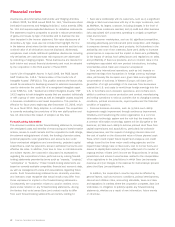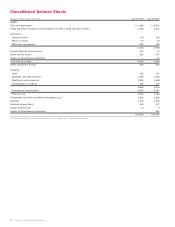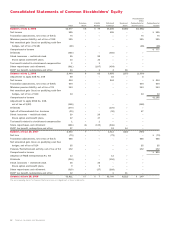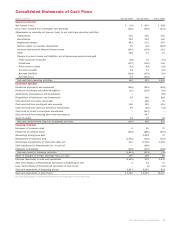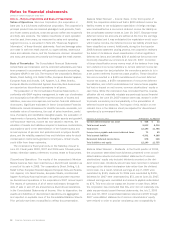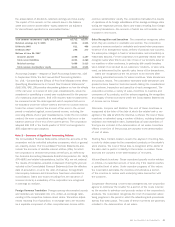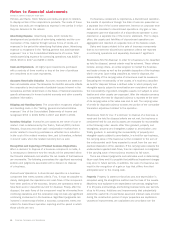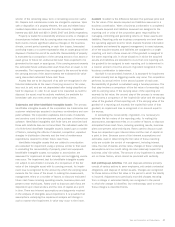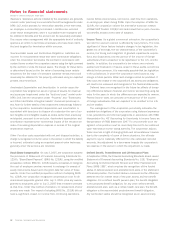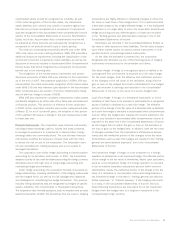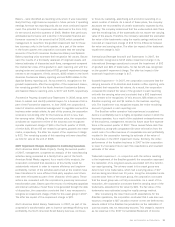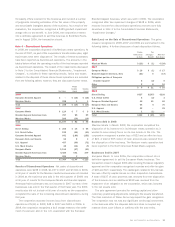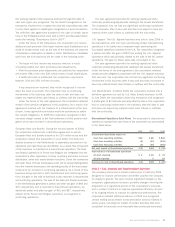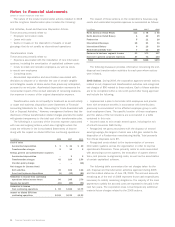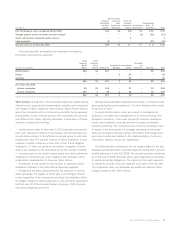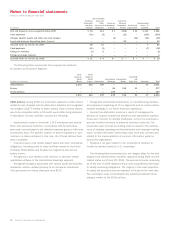Sara Lee 2008 Annual Report Download - page 50
Download and view the complete annual report
Please find page 50 of the 2008 Sara Lee annual report below. You can navigate through the pages in the report by either clicking on the pages listed below, or by using the keyword search tool below to find specific information within the annual report.Notes to financial statements
Dollars in millions except per share data
Severance
Severance actions initiated by the corporation are generally
covered under previously communicated benefit arrangements under
SFAS 112, which provides for termination benefits in the event that
an employee is involuntarily terminated. Liabilities are recorded
under these arrangements when it is probable that employees will
be entitled to benefits and the amount can be reasonably estimated.
This occurs when management with the appropriate level of authority
approves an action to terminate employees who have been identi-
fied and targeted for termination within one year.
Noncancelable Lease and Contractual Obligations
Liabilities are
incurred for noncancelable lease and other contractual obligations
when the corporation terminates the contract in accordance with
contract terms or when the corporation ceases using the right conveyed
by the contract or exits the leased space. The charge for these items
is determined based on the fair value of remaining lease rentals
reduced by the fair value of estimated sublease rentals that could
reasonably be obtained for the property, estimated using an expected
present value technique.
Accelerated Depreciation and Amortization
In certain cases the
corporation has targeted an asset or group of assets for disposal
and assesses impairment under the “held and used” model under
SFAS 144. See the description under “Property” and “Trademarks
and Other Identifiable Intangible Assets” discussed previously in
this Note for further details of the impairment methodology followed
by the corporation. Accelerated depreciation and amortization is
associated with decisions to dispose of or abandon the use of cer-
tain tangible and intangible assets at dates earlier than previously
anticipated, pursuant to an exit plan. Accelerated depreciation and
amortization represents the incremental impact of the revised esti-
mate of remaining depreciation expense in excess of the original
depreciation expense.
Other
For other costs associated with exit and disposal activities, a
charge is recognized at its fair value in the period in which the liability
is incurred, estimated using an expected present value technique,
generally when the services are rendered.
Stock-Based Compensation On July 3, 2005, the corporation adopted
the provisions of Statement of Financial Accounting Standards No.
123(R), “Share-Based Payment” (SFAS No. 123(R)), using the modified
prospective method. SFAS No. 123(R) requires companies to recognize
the cost of employee services received in exchange for awards of
equity instruments based upon the grant date fair value of those
awards. Under the modified prospective method of adopting SFAS
No. 123(R), the corporation recognized compensation cost for all
share-based payments granted after July 3, 2005, plus any awards
granted to employees prior to July 3, 2005 that remained unvested
at that time. Under this method of adoption, no restatement of prior
periods was made. The impact of adopting SFAS No. 123(R) did not
have a significant impact on income from continuing operations,
income before income taxes, net income, cash flow from operations
or earnings per share during 2006. Upon the adoption of SFAS No.
123(R), the corporation utilized the alternative transition method
of FASB Staff Position 123(R)-C and determined that no pool of excess
tax benefits existed at the date of adoption.
Income Taxes As a global commercial enterprise, the corporation’s
tax rate from period to period is affected by many factors. The most
significant of these factors includes changes in tax legislation, the
global mix of earnings, the tax characteristics of the corporation’s
income, the timing and recognition of goodwill impairments, acquisi-
tions and dispositions and the portion of the income of foreign
subsidiaries that is expected to be repatriated to the U.S. and be
taxable. In addition, the corporation’s tax returns are routinely
audited and finalization of issues raised in these audits sometimes
affects the tax provision. It is reasonably possible that tax legislation
in the jurisdictions in which the corporation does business may
change in future periods. While such changes cannot be predicted, if
they occur, the impact on the corporation’s tax assets and obligations
will need to be measured and recognized in the financial statements.
Deferred taxes are recognized for the future tax effects of tempo-
rary differences between financial and income tax reporting using tax
rates for the years in which the differences are expected to reverse.
Federal income taxes are provided on that portion of the income
of foreign subsidiaries that are expected to be remitted to the U.S.
and be taxable.
The management of the corporation periodically estimates the
probable tax obligations of the corporation using historical experience
in tax jurisdictions and informed judgments in accordance with FASB
Interpretation No. 48 “Accounting for Uncertainty in Income Taxes an
Interpretation of FASB Statement 109.” For a tax benefit to be rec-
ognized, a tax position must be more-likely-than-not to be sustained
upon examination by the taxing authority. The corporation adjusts
these reserves in light of changing facts and circumstances; however,
due to the complexity of some of these situations, the ultimate
payment may be materially different from the estimated recorded
amounts. Any adjustment to a tax reserve impacts the corporation’s
tax expense in the period in which the adjustment is made.
Defined Benefit, Postretirement and Life-Insurance Plans
In September 2006, the Financial Accounting Standards Board issued
Statement of Financial Accounting Standards No. 158, “Employers’
Accounting for Defined Benefit Pension and Other Postretirement
Plans (SFAS 158)”, which requires the recognition of the funded
status of defined pension and postretirement plans in the statement
of financial position. The funded status is measured as the difference
between the fair market value of the plan assets and the benefit
obligation. For a defined benefit pension plan, the benefit obligation
is the projected benefit obligation; for any other defined benefit
postretirement plan, such as a retiree health care plan, the benefit
obligation is the accumulated postretirement benefit obligation.
Any overfunded status should be recognized as an asset and any
48 Sara Lee Corporation and Subsidiaries


